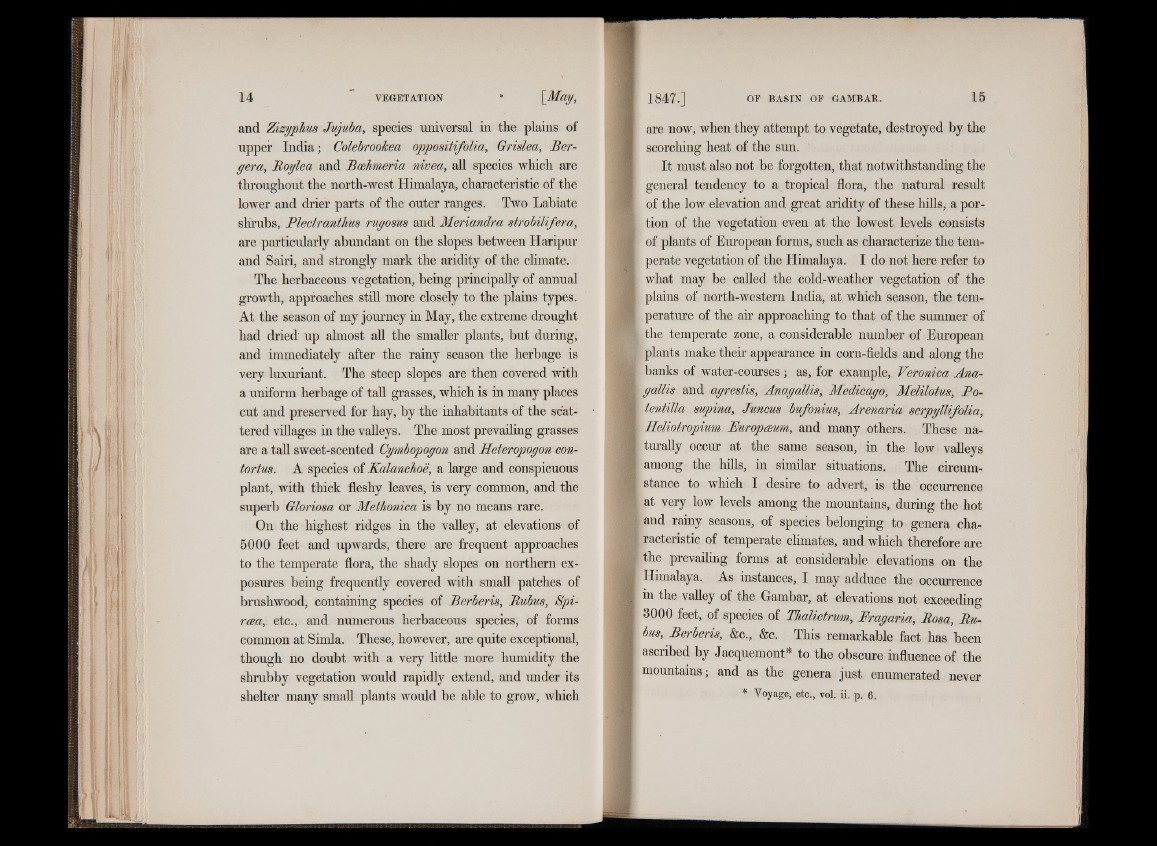
and Zizyphus Jv/juba, species universal in the plains of
upper India; Colebrookea oppositifolia, Grislea, Ber-
gera, Boylea and Boehmeria nivea, all species which are
throughout the north-west Himalaya, characteristic of the
lower and drier parts of the outer ranges. Two Labiate
shrubs, Plectranthus rugosus and Meriandra strobilifera,
are particularly abundant on the slopes between Haripur
and Sairi, and strongly mark the aridity of the climate.
The herbaceous vegetation, being principally of annual
growth, approaches still more closely to the plains types.
At the season of my journey in May, the extreme drought
had dried' up almost all the smaller plants, but during,
and immediately after the rainy season the herbage is
very luxuriant. The steep slopes are then covered with
a uniform herbage of tall grasses, which is in many places
cut and preserved for hay, by the inhabitants of the scattered
villages in the valleys. The most prevailing grasses
are a tall sweet-scented Cymbopogon and Heteropogon con-
tortus. A species of Kalanchoe, a large and conspicuous
plant, with thick fleshy leaves, is very common, and the
superb Gloriosa or Methonica is by no means rare.
On the highest ridges in the valley, at elevations of
5000 feet and upwards, there are frequent approaches
to the temperate flora, the shady slopes on northern exposures
being frequently covered with small patches of
brushwood, containing species of Berberis, Rubus, Spi-
rcea, etc., and numerous herbaceous species, of forms
common at Simla. These, however, are quite exceptional,
though no doubt with a very little more humidity the
shrubby vegetation would rapidly extend, and under its
shelter many small plants would be able to grow, which
are now, when they attempt to vegetate, destroyed by the
scorching heat of the sun. '
It must also not be forgotten, that notwithstanding the
general tendency to a tropical flora, the natural result
of the low elevation and great aridity of these hills, a portion
of the vegetation even at the lowest levels consists
of plants of European forms, such as characterize the temperate
vegetation of the Himalaya. I do not here refer to
what may be called the cold-weather vegetation of the
plains of north-western India, at which season, the temperature
of the air approaching to that of the summer of
the temperate zone, a considerable number of European
I plants make their appearance in corn-fields and along the
I banks of water-courses; as, for example, Veronica Ana-
B gallis and agrestis, Anagallis, Medicago, Melilotus, Po-
I ientilla supina, Juncus bufonius, Arenaria serpyttifdlia,
I Heliotropium Fkropcmm, and many others. These na-
I turally occur at the same season, in the low valleys
I among the hills, in similar situations. The cireum-
B stance to which I desire to advert, is the occurrence
I at very low levels among the mountains, during the hot
B and rainy seasons, of species belonging to genera cha-
■ racteristic of temperate climates, and which therefore are
I the prevailing forms at considerable elevations on the
I Himalaya. As instances, I may adduce the occurrence
■ valley of the Gambar, at elevations not exceeding
I 3000 feet, of species of Thalictrum, Fragaria, Rosa, Ru-
I bus, Berberis, &c., &c. This remarkable fact has been
I ascribed by Jacquemont* to the obscure influence of the
I mountains; and as the genera just enumerated never
* Voyage, etc., vol. ii. p. 6.